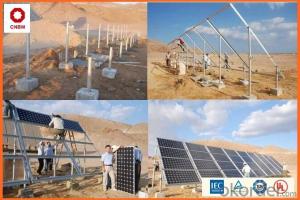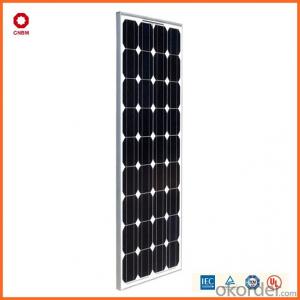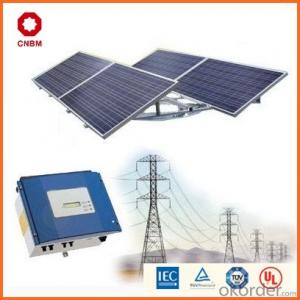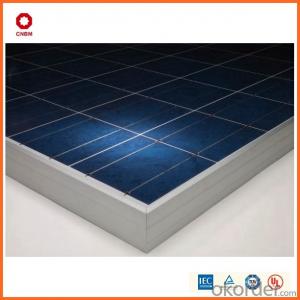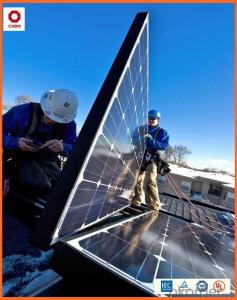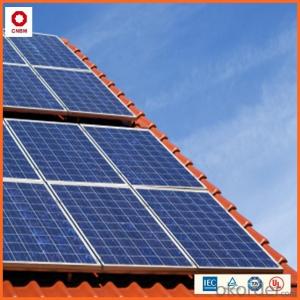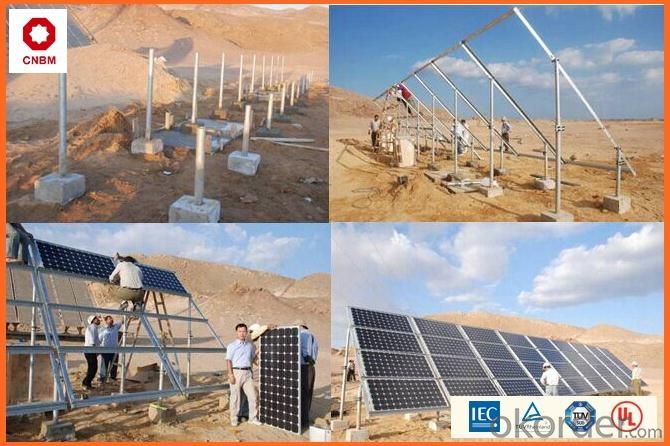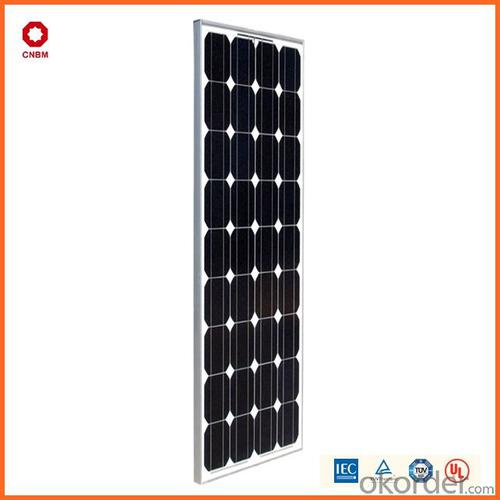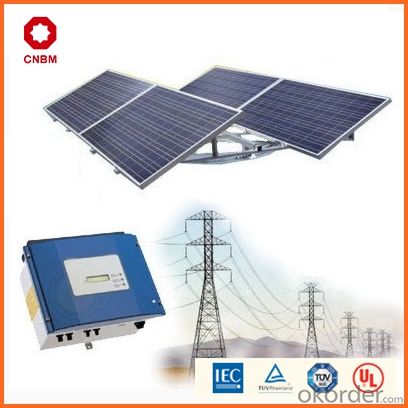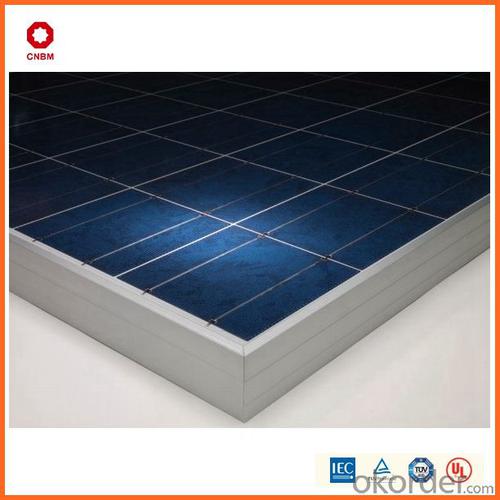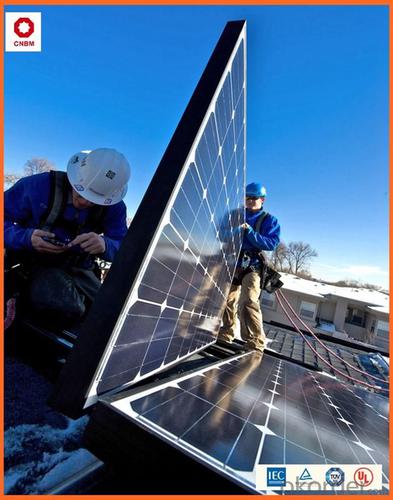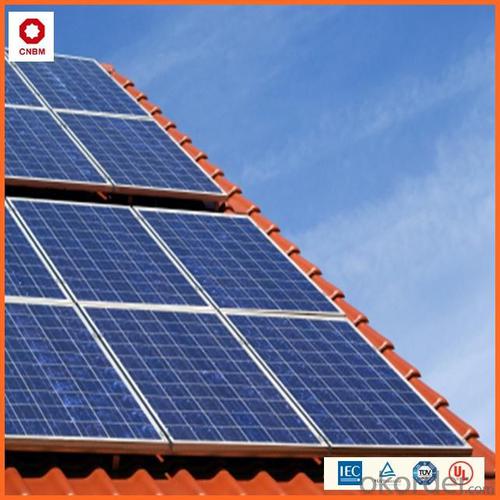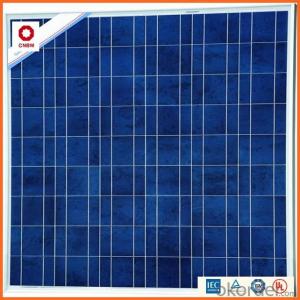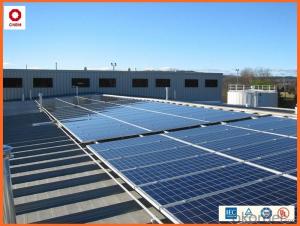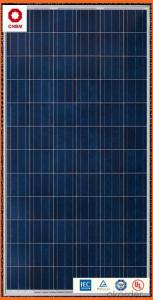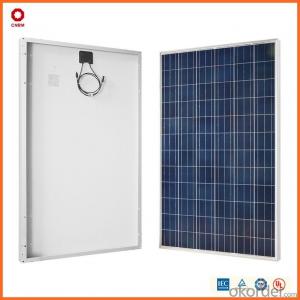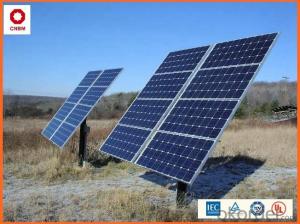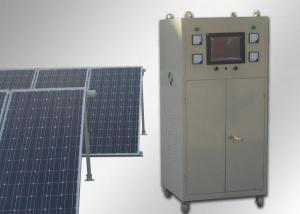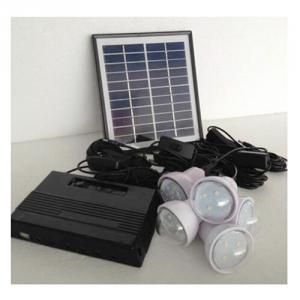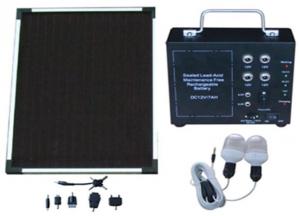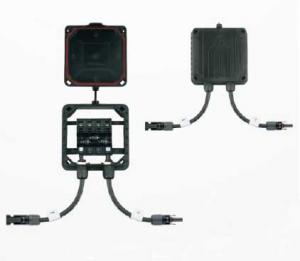Solar Energy Systems Llc 85w Small Solar Panels In Stock China Manufacturer
- Loading Port:
- China main port
- Payment Terms:
- TT OR LC
- Min Order Qty:
- 1 watt
- Supply Capability:
- 10000000 watt/month
OKorder Service Pledge
OKorder Financial Service
You Might Also Like
Specification
Product Description:
Hot Sale !!! Quality and Safety of Small Poly Solar Panel 5w~150w
1. Rigorous quality control meets the highest international standards.
2. High-transmissivity low-iron tempered glass, strong aluminium frame.
3. Using UV-resistant silicon.
4. IS09001/14001/CE/TUV/UL
Warranties of Small Poly Solar Panel 35~85w
1. 10 years limited product warranty
2. 15 years at 90% of the minimal rated power output
3. 25 years at 80% of the minimal rated power output
Specification
Characteristics of Poly solar panels CNBM (245-320W) | |||||
Max Power Voltage Vmp(V) | 30.3 | 30.8 | 31.1 | 31.4 | 31.85 |
Max Power Current Imp(A) | 7.60 | 7.64 | 7.73 | 7.81 | 7.85 |
Open Circuit Voltage Voc(V) | 36.1 | 36.6 | 37 | 37.3 | 37.68 |
Short Circuit Current Isc(A) | 8.50 | 8.55 | 8.65 | 8.75 | 8.85 |
Max Power Pm(W) | 230W | 235W | 240W | 245W | 250W |
Temperature Coefficient of Cells Poly solar panels CNBM (245-320W) | |
NOCT | 45± 2 |
Temperature Coeffucients of Isc | 0.0492 |
Temperature Coeffucients of Voc | -0.3374 |
Temperature Coeffucients of Voc | -0.4677 |
Mechanical Data of Poly solar panels CNBM (245-320W) | |
Dimension | 1638 × 982 × 40 mm |
Weight | 19.5 kg |
No. of Cells and Connections | 60 (6 ×10) |
Tolerance | 0 ~ + 5 W |
Cell | Monocrystalline Cell 156 × 156 mm |
Packing | 624 Pcs/40ft(H) Container |
Limits of Poly solar panels CNBM (245-320W) | |
Operating Temperature | -40 to +85 |
Storage Temperature | -40 to +85 |
Max System Voltage | 1000VDC(IEC) / 600VDC(UL) |
Features of our products:
• High conversion efficiency mono/poly-crystalline amorphous silicon solar cells
• Modules incorporate high performance bypass diodes to minimize the power drop caused by shading
• High transmittance, low-iron tempered glass
• High performance EVA encapsulant to prevent destroying and water.
• AI frame: without screw, corner connection. 8 holes on the frame can be installed easily
• Good performance of preventing from atrocious weather such as wind and hails
• Certifications: CE IEC TUV VDE UL, Class I
• 10 years 90% power output warranty
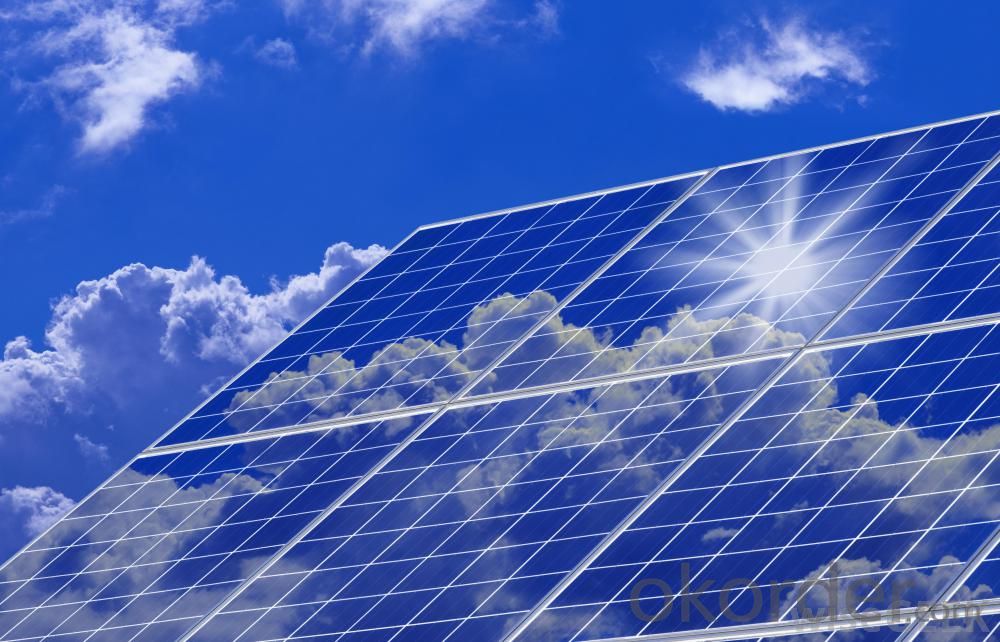
Shipping of Small Poly Solar Panel 35~85w
By Sea | Delivery from Shanghai or Ningbo seaport |
By Air | Departure from Shanghai Pudong Airport |
By Express | Post by DHL, EMS, UPS, TNT. |
Features of our products:
• High conversion efficiency mono/poly-crystalline amorphous silicon solar cells
• Modules incorporate high performance bypass diodes to minimize the power drop caused by shading
• High transmittance, low-iron tempered glass
• High performance EVA encapsulant to prevent destroying and water.
• AI frame: without screw, corner connection. 8 holes on the frame can be installed easily
• Good performance of preventing from atrocious weather such as wind and hails
• Certifications: CE IEC TUV VDE UL, Class I
• 10 years 90% power output warranty
As a professional Solar Panel manufacturer and Supplier in China, we have our customers come around the whole world and our specialization has got a worldwide recognition. Meanwhile, with our superior quality, competitive price, prompt and excellent service, As main role in trade section of CNBM Group, CNBM International Corporation supplies products including Monocrystalline Solar Panel, Polycrystalline Solar Panel ( multicrystalline silicon Solar Panel) have received and enjoyed famous reputation in many countries and regions in the world.
- Q: How do solar energy systems impact greenhouse gas emissions?
- Solar energy systems have a significant positive impact on greenhouse gas emissions as they generate electricity without producing any greenhouse gases during operation. By replacing traditional fossil fuel-based power sources, solar energy reduces the overall amount of greenhouse gases released into the atmosphere, thus helping mitigate climate change.
- Q: Can solar energy systems be used in areas with strict building codes?
- Yes, solar energy systems can be used in areas with strict building codes. While building codes may impose certain limitations or requirements on the installation and design of solar energy systems, there are various ways to comply with these regulations. For instance, the design can be adapted to meet aesthetic and structural requirements, and permits can be obtained to ensure compliance with safety and building standards. Additionally, many jurisdictions have incorporated provisions that facilitate the installation of solar energy systems, recognizing their environmental and energy-saving benefits. Overall, with proper planning, consultation with local authorities, and adherence to building codes, solar energy systems can be successfully implemented in areas with strict regulations.
- Q: Can solar energy systems be used in areas with limited access to solar energy consultants?
- Yes, solar energy systems can still be used in areas with limited access to solar energy consultants. While it may be challenging to have professional assistance, there are resources available online, guides, and tutorials that can help individuals and communities in these areas understand and set up solar energy systems. Additionally, some companies offer remote consultations and support services, making it possible to overcome the limitations of physical access to solar energy consultants.
- Q: Can solar energy systems be used in powering movie theaters or entertainment venues?
- Yes, solar energy systems can definitely be used to power movie theaters or entertainment venues. Movie theaters and entertainment venues require a significant amount of electricity to operate their lighting, sound systems, projectors, and other equipment. Solar energy systems can generate clean and renewable electricity by harnessing the power of the sun. By installing solar panels on the roofs or surrounding areas of these venues, they can generate a substantial amount of electricity to meet their energy needs. Solar energy systems can be designed to provide enough power to not only run the basic infrastructure of movie theaters or entertainment venues but also to support additional energy-intensive features such as heating, ventilation, and air conditioning (HVAC) systems, concession stands, and even electric vehicle charging stations. By utilizing solar energy, these venues can significantly reduce their reliance on grid electricity, lower their operational costs, and contribute to a more sustainable and eco-friendly future. In addition to the practical benefits, installing solar energy systems in movie theaters or entertainment venues can also serve as a statement of environmental responsibility and attract environmentally conscious audiences. Many people are becoming increasingly aware of the importance of renewable energy, and by showcasing their commitment to sustainability, these venues can enhance their brand image and appeal to a broader customer base. Overall, the utilization of solar energy systems in powering movie theaters or entertainment venues is not only technically feasible but also financially and environmentally advantageous. By harnessing the power of the sun, these venues can reduce their carbon footprint, save on energy costs, and contribute to a greener future for the entertainment industry.
- Q: Can solar energy systems be used in areas with strict building codes or historical preservation restrictions?
- Yes, solar energy systems can be used in areas with strict building codes or historical preservation restrictions. While it may require some additional planning and design considerations, it is certainly possible to integrate solar energy systems into the existing structures in these areas. One way to incorporate solar energy systems is by using building-integrated photovoltaics (BIPV) or solar thermal systems that are seamlessly integrated into the building's design. These systems can be installed on rooftops, facades, or even as shading elements, ensuring that the historical aesthetics or architectural integrity of the building are not compromised. Furthermore, advancements in solar technology have allowed for the development of more visually appealing solar panels, such as solar tiles or transparent solar windows, which can blend in with the existing building materials. This makes it easier to gain approval from historical preservation boards or building code authorities. It is important to note that in areas with strict building codes or historical preservation restrictions, the approval process for installing solar energy systems may be more complex. It may require obtaining permits, conducting structural assessments, and working closely with local authorities to ensure compliance with regulations. However, with the growing recognition of the importance of renewable energy, many jurisdictions have developed specific guidelines and provisions for integrating solar systems in historic areas. In summary, solar energy systems can be used in areas with strict building codes or historical preservation restrictions by employing BIPV, solar thermal systems, or visually appealing solar panels. While the approval process may be more involved, with proper planning and adherence to guidelines, it is possible to harness solar energy without compromising the architectural or historical significance of the area.
- Q: What is the impact of shade from nearby buildings or trees on the performance of solar panels?
- The impact of shade from nearby buildings or trees on the performance of solar panels is significant. Shade reduces the amount of sunlight reaching the panels, which in turn decreases their efficiency. Even a small amount of shade can have a noticeable impact on the overall power output of the panels. It is crucial to ensure that solar panels are installed in locations with minimal shade to maximize their performance and energy generation.
- Q: Can solar energy systems be used in commercial buildings?
- Yes, solar energy systems can be used in commercial buildings. In fact, many businesses and organizations are increasingly adopting solar power systems to meet their energy needs and reduce their carbon footprint. These systems can be installed on rooftops or as ground-mounted arrays, providing clean and renewable energy to power various operations in commercial buildings. Additionally, commercial buildings often have larger roof spaces available, making them well-suited for efficient solar panel installation.
- Q: Can solar energy systems be used in areas prone to hurricanes or typhoons?
- Yes, solar energy systems can be used in areas prone to hurricanes or typhoons. However, they need to be designed and installed with proper precautions and considerations for the extreme weather conditions. This includes using hurricane-resistant solar panels and securing the system to withstand strong winds. Additionally, backup power storage systems can be incorporated to ensure continuous energy supply during power outages caused by the storms.
- Q: Can solar energy systems be installed on mobile homes or RVs?
- Yes, solar energy systems can be installed on mobile homes or RVs. With advancements in technology, portable solar panels and battery systems have become more compact and efficient, making it possible to harness solar energy for these mobile structures. This allows for greater energy independence and the ability to power various appliances and devices while on the move.
- Q: What is the lifespan of solar batteries?
- The lifespan of solar batteries can vary depending on several factors. Generally, high-quality solar batteries can last anywhere from 5 to 15 years. However, with proper maintenance and care, some batteries have been known to last up to 20 years or more. The lifespan of solar batteries is influenced by factors such as the type and quality of the battery, the depth of discharge (how much energy is used before recharging), the frequency of charging and discharging cycles, and the overall maintenance of the battery system. It's important to note that over time, the capacity of solar batteries may decrease, resulting in reduced energy storage capabilities. This gradual decline in capacity is known as battery degradation. While it is an inevitable process, proper care and maintenance can help slow down the rate of degradation. Regularly monitoring the battery's state of charge, avoiding deep discharges, and ensuring proper ventilation and temperature control can all contribute to prolonging the lifespan of solar batteries. Additionally, following the manufacturer's guidelines for maintenance and replacement can help maximize their longevity. Overall, investing in high-quality solar batteries, coupled with proactive maintenance, can significantly extend their lifespan, providing reliable and sustainable energy storage for your solar power system.
Send your message to us
Solar Energy Systems Llc 85w Small Solar Panels In Stock China Manufacturer
- Loading Port:
- China main port
- Payment Terms:
- TT OR LC
- Min Order Qty:
- 1 watt
- Supply Capability:
- 10000000 watt/month
OKorder Service Pledge
OKorder Financial Service
Similar products
Hot products
Hot Searches
Related keywords
